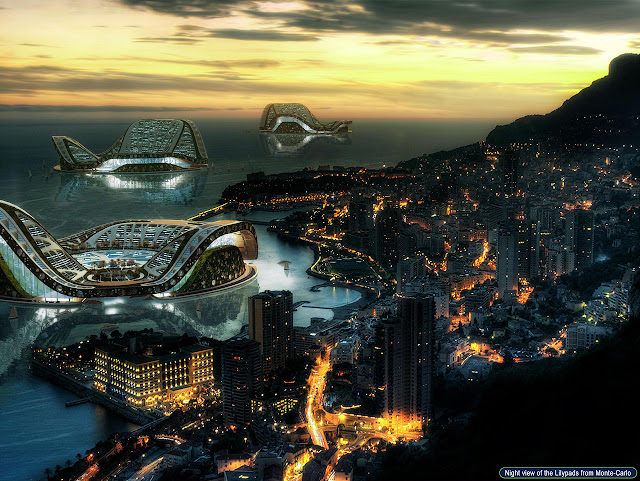
Em tempos de Tsunamis desastrosos no Japão e o degelo, uma cidade como esta está cada vez mais viável. 
O Arquiteto Vincent Callebaut , criou um Lilypad, uma cidade flutuante para 50 mil pessoas que possui três Setores:
Trabalho, Entretenimento e Moradia. 
No centro um lago serve de reservatório para a água da chuva e assim as pessoas terão água potável. 
Outras áreas são utilizadas para plantio de hortas. 
Ela utiliza diversas captações de energia como eólica, solar e térmica. 
Matéria completa do site http://www.eikongraphia.com/?p=2490
Everybody copies from each other, Winy Maas – frontman of MVRDV – has stated at more than one occasion. What is more interesting, he adds, is how we can build on each other’s ideas: invention follows invention follows invention.
A couple years ago there was a ‘hausse’ of towers that leaned into each other. At the height of the euphoria over that invention United Architects did a proposal like that for the WTC-site in New York. MVRDV envisioned it for Vienna.
Really interesting is that the idea of the touching towers is now becoming reality in smaller projects. In the city of Heerlen a residential building designed by Mecanoo is planned, which visually seems to consist of two towers that touch each other and at the top each go their own way. In The Hague an office building by OMA is planned in which the top floors connect to create a ‘street’ where additional collective program, like fitness facilities or café’s, can find a place.
The similarity between the round water-city-blocks designed by BIG and Vincent Callebautis promising. A couple more of such proposals and we can be almost sure it’s going to be realized! Speaking with Winy Maas, here the invention is also followed by another invention. Whereas the city block (actually a dolfinarium) by BIG doesn’t float and lies still in the water, Vincent Callebaut proposes a configuration where some of his city blocks move around the globe on the current of the sea.
The circular band that constitute the design of Callebaut seems like the most stable form to build on water. It’s like a rescue vest. Additionally a floating structure has to be weighted equally for its stability. That especially goes up for for the design by Vincent Callebaut: these structures have to survive a storm on the open water. Would that be the reason why the structure is so overdimensioned? In his statement Callebaut that the structure is based on that of a lily pad. He doesn’t state an argument with that decision. I can’t think of one either.
It seems like a highly inefficient structure without a lifeline, a stem, in the centre of the structure. It still could be an attractive image that would contextually relate the design to the water, if the architect hadn’t covered the structure from all sides. It’s completely invisible.
Callebaut suggests his design provides an answer to global warming. Because the sea level is rising, low areas around the world will be flooded, he argues. The answer: conquer the sea with floating structures.
The Dutch, who in Callebaut’s calculations will lose 8% of their land to the rising sea level, are already thinking in the same direction. In the part of the country below sealevel, everywhere small initiatives pop-up that involve floating houses. The most ambitious and radical plan until now is to create vast areas of floating greenhouses.
The floating city-blocks of Vincent Callebaut made me think of the helicopter archipelagoes Geoff Menaugh has described: an imagined, hovering city, made up of helicopters. With the price of oil rocketing, that scenario seems increasingly improbable. The idea of a nomadic, self-reliant, civilization however strongly appeals to me.
I wonder: would it ever be possible to create a floating civilization, that could actually feed and power itself? Vincent Callebaut’s doesn’t answer either of that questions, although he suggest his ‘roundabout’ would produce power. How exactly?
Will it one day be possible to create floating farmland? The recent interest in algae could be pointing in the right direction: what about large stretches of cultivated algae among floating clusters of housing?
Nenhum comentário:
Postar um comentário